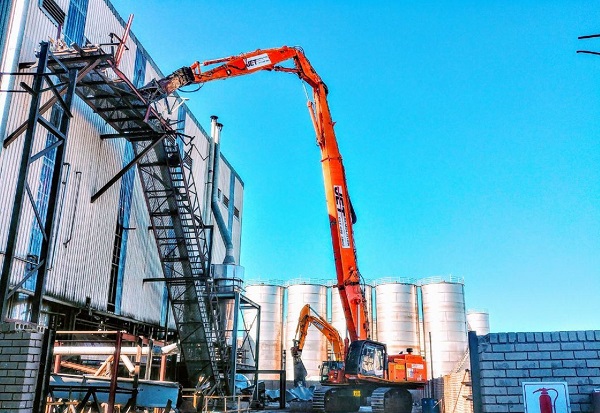
Demolition is an essential part of construction and development, with new tools and innovative techniques constantly being developed to boost its efficiency and safety.
The aim is not only to reduce the time and cost of demolition projects, but also to reduce the environmental impact, says Kate Bester, Project and Contracts Manager at Jet Demolition.
The demolition specialist has an extensive fleet of 33 demolition excavators, ranging from 1.4 t to a 102 t high-reach excavator.
High-reach excavators can reach up to several storeys high and can easily tear down high-rise buildings, bridges and other large structures. They are sufficiently robust to handle heavy loads and can be fitted with various attachments.
“The risk of personnel working at heights is one that every demolition company faces,” comments Bester.
“Our specialised high-reach demolition excavator is compatible with our range of imported and proprietary demolition tools, enabling the safe and controlled demolition of tall structures, without exposing our personnel to risk.”
Excavators are extremely versatile and form the backbone of Jet Demolition’s fleet. Telescopic handlers are ideal for handling materials and providing safe access to elevated structures.
Skidsteer loaders are compact, versatile and can manoeuvre in constrained spaces and be fitted with various attachments to increase their flexibility.
Front-end loaders focus on material handling, while tool master loaders are designed for specialised tasks. Rounding out the fleet are the standard rigid dump trucks and articulated dump trucks seen on any construction site.
“Our approach on a typical demolition project is to deploy different sized modified excavators according to the scope, spatial constrains and project duration,” explains Bester.
For example, a demolition excavator may be equipped with a hydraulic hammer for concrete demolition, or a hydraulic shear might be called for to demolish steel structures. Mechanical grapples load scrap steel while buckets convey rubble generated by demolition activities.
For larger industrial projects, Jet Demolition deploys boom extensions and pulling tools to safely demolish structures that are out of reach for conventional excavators.
Hydraulic shears weighing up to 10 t are used to process and demolish heavy steel members, avoiding conventional hot-work methods. Furthermore, hydraulically driven magnet attachments can recover small steel sections from rubble, efficiently.
“Our flexibility allows us to tackle unique challenges and optimise our demolition processes,” says Bester.
What sets Jet Demolition apart is that it owns all its equipment. “We invest heavily in our fleet, and always have direct access to whichever item of equipment we require, without being dependent on external providers,” highlights Bester.
Core equipment was traditionally replaced at the 6 000-hour mark, but advancements in technology and higher-quality consumables have extended machine retention up to 10 000 hours.
Also Read
South Africa’s market-leading safety footwear styles a testament to local development
BFF Safety: New clear arc flash visor for maximum safety and protection

